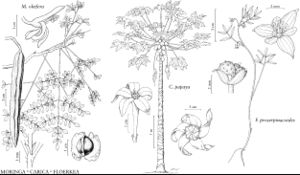Carica
Sp. Pl. 2: 1036. 1753.
Gen. Pl. ed. 5, 458. 1754.
| Taxon | Illustrator ⠉ | |
|---|---|---|
 | Moringa oleifera Carica papaya Floerkea proserpinacoides | Barbara Alongi Linny Heagy Barbara Alongi |
Trees relatively short-lived. Leaves crowded distally on branches; glabrous. Inflorescences: staminate 100+-flowered, elongate; pistillate 1–several-flowered. Flowers each borne in axil of bract. Berries slightly 5-angled. x = 9.
Distribution
Introduced; Fla., Central America, South America, also pantropically
Discussion
Species, in the traditional sense, ca. 20 (1 in the flora).
V. M. Badillo (2000) considered Carica to consist of only one species (C. papaya), others being reassigned to the genus Vasconcellea A. Saint-Hilaire.
Some species of Carica in the traditional sense are grown for their edible fruits or sweet and juicy seed coverings (arils), the most important being C. papaya.
Species, in the traditional sense, ca. 20 (1 in the flora)
Selected References
None.